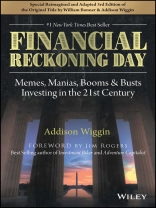An engaging and practical romp through contemporary financial and economic history–and what it means for your financial future
Economic booms and busts are happening with more frequency. Since the turn of the new millennium, fortunes have been made and lost at a blistering pace. Each boom is like the tension building up before an earthquake. Seismologists can detect the build-up, but they can’t necessarily explain why–or when–the next quake will hit. Economic busts can be equally devastating…and followed by numerous aftershocks.
In this entertaining romp through recent economic and financial history, best-selling author, Addison Wiggin, traces the primary trends that have led up to rapid economic growth and innovation while keeping an eye on the inevitable downturn. The author practices ‘literary economics, ‘ telling stories about the characters behind the scenes and their motives, making this wide-ranging book easy-to-read. The current edition has been revised, adapted, and re-imagined, enlightening readers about what’s happening behind today’s top headlines:
* The rise of new financial innovations over the past decade, including cryptocurrencies, mobile trading platforms, and the democratization of financial markets
* How the policies of the Federal Reserve following the Panic of ’08 led an entire generation to become unwitting speculators in stocks, bonds, real estate, and rare commodities
* What impact new political trends–environmental, social, governance (ESG) and diversity equity and inclusion (DEI)–have had on managing your own money
Ultimately, the book helps place current events in the context of identifiable historical trends. The book proposes that when you understand what the primary trends are and follow them to their logical conclusion, it makes planning for your financial future much easier.
What will be the role of the US economy in the future as policy makers try to grapple with new competition, economic and political, from Brazil, Russia, India, China – the so-called BRICs? The author follows the facts, the trends, and the stories that make up history and parlays them into forecasts for what he sees coming next. Ultimately, you’ll get a review of previous trades and a new Trade of the Decade.
表中的内容
Foreword ix
Preface to the 2009 Edition: Confessions of a Newsletter Man xiii
Acknowledgments xxv
Introduction: Hell in a Bucket 1
Part One: Wildness Lies in Wait 9
Chapter 1: The Old ‘New Economy’ 11
Chapter 2: Homo Digitalis, or ‘If You Know, You Know’ 25
Chapter 3: Dreamers and Schemers 35
Part Two: The Fabulous Destiny of Alan Greenspan 49
Chapter 4: In the Bath Blowing Bubbles 51
Chapter 5: ‘Free Money’ and Other New Era Hallucinations 63
Chapter 6: A Theory of Moral Hazards 95
Chapter 7: First It Giveth . . . 113
Part Three: Extraordinary Popular Delusions 127
Chapter 8: John Law and the Origins of a Bad Idea 129
Chapter 9: The Digital Age of Crowds 147
Chapter 10: The Crack-Up Boom 169
Chapter 11: The Party at the End of the World 225
Notes 235
Index 245
关于作者
ADDISON WIGGIN is a best selling writer, publisher, and filmmaker, with over two decades of experience. An acclaimed New York Times best selling author, his books also include: Demise of the Dollar, Empire of Debt, and The Little Book of the Shrinking Dollar. Addison is the writer and executive producer of the documentary I.O.U.S.A., an exposé on the national debt, shortlisted for an Academy Award. Addison started his latest project, a podcast called The Wiggin Sessions, during the pandemic in a tornado warning. He films from a homegrown studio in Baltimore, Maryland where he lives with his family. Addison has interviewed, at length, many of the world’s most accomplished financiers, investors, politicians and executives.
JAMES BEELAND ROGERS JR. is an American investor and financial commentator based in Singapore. Rogers is the chairman of Beeland Interests, Inc. He was the co-founder of the Quantum Fund and Soros Fund Management. He was also the creator of the Rogers International Commodities Index (RICI).












